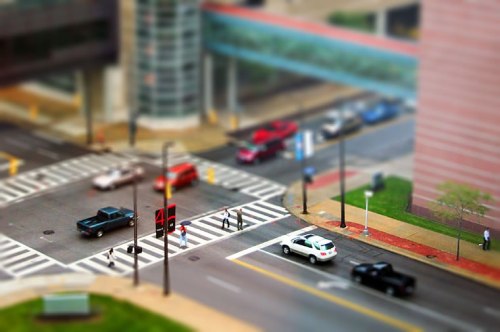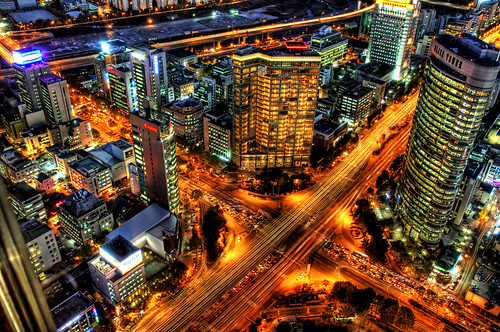
Thursday, April 30, 2009
Visiting Artist: Paul Shambroom


Paul Shambroom had many documentary style shots of various factories and weapons facilities. Some of them seemed to portray a decisive moment, but for the most part he seemed to try to leave any subjective composition or focus out, letting the visuals of each location speak for themselves. The subject matter of the weapons facilities and bases was very interesting to me, and I enjoyed getting a firsthand look at them. There were only a few outdoor shots of the facilities however, and I found myself wanting to see more of the surrounding landscapes as well as the interiors.
Of the more recent work, I enjoyed the shots of local government meetings the most, as they captured a lot of character in the faces and rooms. The similar way each shot was taken also contributed to the series as a whole, showing careful composing but also maintaining objectivity. The photoshopped portraits were interesting but i felt could have been created on location with good lighting to be more successful than layer blending. The weapons and vehicles on public display just seemed too much like tourist photos and were not as interesting as the real thing.
He did have some good advice about gaining access to restricted locations though, something that I've always struggled with. He stressed knowing what you're asking for and why you would be denied access, as well as being sure not to lie while making good use of flattery and maintaining patience.

Wednesday, April 29, 2009
Visiting Artist: Alix Pearlstein

Alix Pearlstein presented video clips with various actors performing specific interactions, often in an over-dramatic manner. The sets were not attempting to be realistic, many of them simple white backdrops with the actors shown walking into the space before performing. The sound usage was also recorded separately and added in post production intentionally out of sync and somewhat comical.
The most interesting films to me by far were the ones that presented multiple channels of video, shot simultaneously with separate cameras in single, long takes. The dual channel piece was very engaging to me, as i found myself constantly trying to situate the location of each camera in the room in relation to each other and the actors. The way the cameras started out on opposite sides and panned slowly across the room throughout the film created a very nice effect. The natural lighting in the room was also nice, as it created a blown-out effect in the window. For some reason I really enjoyed being able to see multiple simultaneous views of one room, seeing one camera in the other or at least being able to guess where each camera was. With this style of filming the entire room becomes the set. There's no backdrop or area hidden behind the camera where the director can stand, as the whole room gets in the take. The camera becomes its own entity, traveling about with a purpose that isn't always centered on the performance in front of it. This also gave the ability to see a particular actor close up and also from across the room. The acting in this film was also more intriguing to me. The relative silence and echoes throughout the room were used to great effect and the actions that played out such as the collapse of one of the actors sparked my curiosity more.
The final 4-channel film was also interesting, but what I really enjoyed about the 2-channel one was somewhat lacking here, as the four cameras were enshrouded by black sheets and the darkness of the room. The struggle presented here was engaging, but the limited lighting and presence of more camera angles left me somewhat confused as to where to look and specifically what angle's were presented to me.
http://www.alixpearlstein.com/
Thursday, April 9, 2009
Topic: Tilt-Shift Photography
Tilt-shift photography refers to the use of camera movement, special lenses, or post-production digital means to achieve an interesting combination of blurred and focused imagery. Large format view cameras have the ability to "tilt" the lens separately from the viewfinder, thus creating an unnatural depth of field. Lenses are also available that "shift" up, down, or across parallel to the image plane to avoid the wide angle effect of bending lines. Lenses with similar capabilities are available for other cameras, but any camera can utilize camera movement in which the point of view is changed during the picture to blur some areas but keep others relatively sharp.
I think a good example of this would be taking a photo from a moving car of a distant barn in a field. Depending on the smoothness of the road and the camera, the barn would remain relatively in focus and sharp, as the point of view pertaining to it didn't change much. The fence line in the foreground would be blurry though, and the grass field would start out blurry and become sharper as it retreats towards the barn. If you had focused on, say, the horse in the middle of that field, you would have probably had to angle the camera a bit to keep it centered, thus the fence and the barn would experience motion and focus blur.
The technique I'm most interested in however, is the digital post-production method of blurring an image to simulate a short depth of field. Most of the images are of landscapes, but it can also be utilized more subtly in things like portraits. It's impossible, I'm assuming, to get a short depth of field with the focal point out in the middle of a landscape using any regular size camera. Therefore when this effect is created digitally through blurring, the mind is tricked into thinking this must be a tabletop miniature rather than a lifesize composition. Upon closer scrutiny though, you can see the amount of reality and detail in the landscape. For this reason the method is usually referred to as "tilt-shift miniature faking." I really want to experiment with this and would love to be able to integrate it into my project.



http://en.wikipedia.org/wiki/Tilt-shift_photography
http://en.wikipedia.org/wiki/Tilt-shift_miniature_faking
I think a good example of this would be taking a photo from a moving car of a distant barn in a field. Depending on the smoothness of the road and the camera, the barn would remain relatively in focus and sharp, as the point of view pertaining to it didn't change much. The fence line in the foreground would be blurry though, and the grass field would start out blurry and become sharper as it retreats towards the barn. If you had focused on, say, the horse in the middle of that field, you would have probably had to angle the camera a bit to keep it centered, thus the fence and the barn would experience motion and focus blur.
The technique I'm most interested in however, is the digital post-production method of blurring an image to simulate a short depth of field. Most of the images are of landscapes, but it can also be utilized more subtly in things like portraits. It's impossible, I'm assuming, to get a short depth of field with the focal point out in the middle of a landscape using any regular size camera. Therefore when this effect is created digitally through blurring, the mind is tricked into thinking this must be a tabletop miniature rather than a lifesize composition. Upon closer scrutiny though, you can see the amount of reality and detail in the landscape. For this reason the method is usually referred to as "tilt-shift miniature faking." I really want to experiment with this and would love to be able to integrate it into my project.



http://en.wikipedia.org/wiki/Tilt-shift_photography
http://en.wikipedia.org/wiki/Tilt-shift_miniature_faking
Sunday, April 5, 2009
Artist: James O. Phelps

 James O. Phelps takes seamless 360 degree panoramic photos that were displayed this past 'First Friday' at Corporate & Museum Frame, Inc. There were at least 20 or so photos displayed, all fairly small around 30" x 6". Quite a few of the shots were of historical locations, such as battlegrounds, museums, or the UVA campus. These were less interesting to me, but the shots of landscapes and Richmond locales were amazing. Most of them had the kind of foreground and background terrain elements that make panoramics so engulfing to look at, and the sky's were often dramatic. The network of underpasses near the Main st. station looked incredible as a panoramic, and Hollywood cemetery was shot from virtually the same spot that I did my panoramic of that location from.
James O. Phelps takes seamless 360 degree panoramic photos that were displayed this past 'First Friday' at Corporate & Museum Frame, Inc. There were at least 20 or so photos displayed, all fairly small around 30" x 6". Quite a few of the shots were of historical locations, such as battlegrounds, museums, or the UVA campus. These were less interesting to me, but the shots of landscapes and Richmond locales were amazing. Most of them had the kind of foreground and background terrain elements that make panoramics so engulfing to look at, and the sky's were often dramatic. The network of underpasses near the Main st. station looked incredible as a panoramic, and Hollywood cemetery was shot from virtually the same spot that I did my panoramic of that location from.

The shots were printed in sepia b&w, which made them look artistic and professional as well as brought attention to the vastness of the technique and fit the historic backdrop. I spoke to him about the process, and in order to create seamless panoramas he actually used a special camera that I hadn't heard of. The lens is reduced to a vertical slit, and the camera spins around, exposing an actual panoramic negative seamlessly. To me it seemed almost like a video camera, as you only adjust the aperture and the shutter speed is determined by how fast the camera spins around. A longer exposure, at dusk for example, would be a slower 360 degree spin. The result is a perfect panoramic, stretched and skewed at places to maintain a seamless state, similar to the effect of a wide angle lens. This was all very interesting to me as I hadn't heard of this type of camera before. Needless to say , I'm impressed at what the artist has done with it.






http://www.jamesophelps.com/index.html
http://www.corporatemuseumframe.com/
http://sagemoongallery.com/Merchant2/merchant.mvc?Screen=CTGY&Store_Code=sagemoon&Category_Code=JPHELPSBIO
Thursday, April 2, 2009
Topic: HDR Photography

High dynamic range imaging allows an image to display a greater range of luminance between light and dark than a single digital image capture would allow. The most common practice is to take a number of exposures of the same composition, each metered for various light and shadow areas. A simple 3-stop bracket is usually enough. These images are then combined digitally, such as through Photoshop, to produce a final product that emulates how our eyes might have adjusted to different lighting conditions throughout the picture. HDR imagery has varying levels of intensity, but for the most part they look almost too perfect, as if created with computer graphics. This is because while our eyes can adjust more quickly and dynamically than a camera can, they still don't see entire scenes with contrasting lighting in perfect exposure throughout, so a picture that employs this seems too good to be true.
The most popular and effective uses are shots at sunrise, sunset, or in the city at night, where lighting conditions often vary drastically throughout the foreground and background of a composition. A sunset at the beach, for example, could be exposed for both the bright sky and the dark surf. In a lot of cases the practice is similar to dodging and burning, but the effect is much nicer due to the fact that multiple photos are used. My image compilations could be seen as using this method to an extent, as each picture in the collage can be exposed differently.


Subscribe to:
Posts (Atom)

